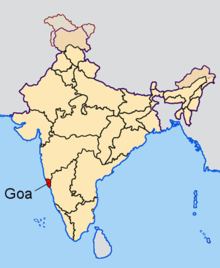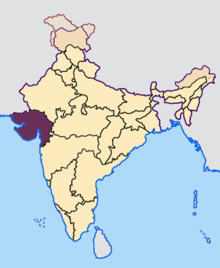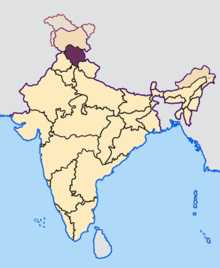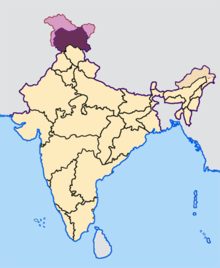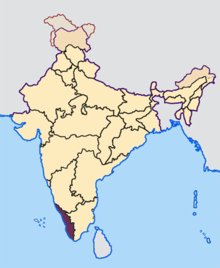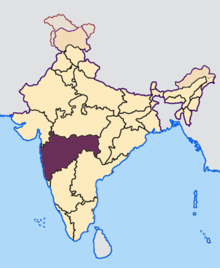Indian general elections, 2004-Regional Scenarios
Andhra Pradesh
In AP Lok Sabha elections and state assembly elections were held simultaneously. In both, the ruling Telugu Desam Party-Bharatiya Janata Party (BJP) combine were routed. BJP could not win a single seat. The Indian National Congress had contested in alliance with Telangana Rashtra Samithi (a TDP splinter group, working for the separation of Telangana from AP) and the communist parties. The Islamist All India Majlis-e-Ittehadul Muslimen retained their stronghold in the Hyderabad constituency.
| Party | Votes | % | Change | Seats | Change |
|---|---|---|---|---|---|
| Bahujan Samaj Party | 507,381 | 1.43 | – | 0 | – |
| Bharatiya Janata Party | 3,006,018 | 8.41 | −1.49 | 0 | −7 |
| Communist Party of India | 479,511 | 1.34 | +0.1 | 1 | +1 |
| Communist Party of India (Marxist) | 373,148 | 1.04 | −0,36 | 1 | +1 |
| Indian National Congress | 14,861,984 | 41.56 | −1.23 | 29 | +24 |
| Communist Party of India (Marxist-Leninist) Liberation | 9,458 | 0.03 | 0.0 | 0 | – |
| Indian Union Muslim League | 16,313 | 0.05 | – | 0 | – |
| Rashtriya Janata Dal | 7,260 | 0.02 | +0.02 | 0 | – |
| Samajwadi Party | 41,770 | 0.12 | +0.7 | 0 | – |
| Telugu Desam Party | 11,844,811 | 33.12 | −6.73 | 5 | −24 |
| All India Majlis-e-Ittehadul Muslimen | 417,248 | 1.17 | −0.17 | 1 | – |
| Telangana Rashtra Samithi | 2,441,405 | 6.83 | – | 5 | +5 |
| Other parties | 272,948 | 7.63 | – | 0 | – |
| Independents | 1,483,415 | 4.15 | +2.74 | 0 | – |
| Total | 35,762,670 | – | – | 42 | – |
Arunachal Pradesh
Party politics in Arunachal had been rather unstable during the last years. In 2003 a major chunk of former Congressmen joined BJP, and formed a government in the state. BJP was for the first time a strong force in the state, and contested both seats. Congress had an alliance with its splinter group Arunachal Congress. Congress candidate and former Arunachal Congress leader Wangcha Rajkumar contested Arunchal East and AC candidate Kamen Ringu contested Arunachal West. Nationalist Trinamool Congress (evolved out of Sangma wing of NCP in the state, a member of the National Democratic Alliance) had a candidate in Arunachal West, competing against BJP. BJP won both seats with comfortable margins.
Polling took place in the state overshadowed by a boycott call from All Arunachal Pradesh Students' Union over the inclusion of Chakma and Hajong refugees in the voters lists.
| Party | Votes | % | Change | Seats | Change |
|---|---|---|---|---|---|
| Bharatiya Janata Party | 207,286 | 53.85 | +37.55 | 2 | +2 |
| Indian National Congress | 38,341 | 9.96 | −46.96 | 0 | −2 |
| Arunachal Congress | 76,527 | 19.88 | +3.26 | 0 | – |
| Nationalist Trinamool Congress (*) | 6,241 | 1.62 | −6.15 | 0 | – |
| Samajwadi Party | 4,901 | 1.27 | – | 0 | – |
| Samata Party | 4,896 | 1.27 | – | 0 | – |
| Independents | 46,736 | 12.14 | – | 0 | – |
| Total | 384,928 | – | – | 2 | – |
(*)= 1999 numbers are those of the Nationalist Congress Party.
Assam
In Assam there was a three-cornered contest between Congress, BJP and Asom Gana Parishad (the main regional party of the state). Congress contested all 14 seats in the states, BJP 12 and AGP 12. BJP supported one JD(U) candidate and the Bodo nationalist candidate in Kokrajhar. The left parties (CPI(M), CPI and CPI(ML)L) had a joint front. Congress won nine seats. AGP got a comeback, winning two seats. BJP also won two seats, although one of them was the popular singer Bhupen Hazarika. Hazarika stood in Guwahati, and his election ought to reflect his personal popularity, rather than that of the party he had just joined. CPI(ML)L lost its seat in the Karbi Anlong hills, largely due to a split in their mass organisation there and the resurgence of communal violence in the area. In Kokrajhar the Bodo nationalist and NDA-supported candidate, Sansuma Khunggur Bwismuthiary, retained his seat.
| Party | Votes | % | Change | Seats | Change |
|---|---|---|---|---|---|
| Bharatiya Janata Party | 2,379,524 | 22.94 | −6.9 | 2 | – |
| Communist Party of India | 172,332 | 1.66 | +1.08 | 0 | – |
| Communist Party of India (Marxist) | 68,627 | 0.66 | −1.11 | 0 | – |
| Indian National Congress | 3637405 | 35.07 | −3.35 | 9 | −1 |
| Asom Gana Parishad | 2,069,600 | 19.95 | +8.03 | 2 | +2 |
| Communist Party of India (Marxist-Leninist) Liberation | 108,837 | 1.05 | −1.12 | 0 | −1 |
| Janata Dal (United) | 125,966 | 1.21 | – | 0 | – |
| Indian Union Muslim League | 3,533 | 0.03 | – | 0 | – |
| Revolutionary Socialist Party | 11,757 | 0.11 | – | 0 | – |
| Samajwadi Party | 109,088 | 1.05 | +0.85 | 0 | – |
| Other parties | 294,482 | 2.84 | – | 0 | – |
| Independents | 1,390,938 | 13.41 | +4.05 | 1 | – |
| Total | 10,372,089 | – | – | 12 | – |
Bihar
In Bihar the RJD leader Laloo Prasad Yadav, husband of the Bihar Chief Minister Rabri Devi, was able to assemble a broad coalition of anti-NDA parties. It included RJD, Congress, Lok Janshakti, NCP and CPI(M). Congress posed larged scepticism towards the coalition, since the party was only allotted four seats by Laloo. The other coalition partners argued that four seats actually reflected the decreasing strength of Congress in the state. Lok Janshakti, a party with strong support amongst Dalit communities, were allotted eight seats. NCP and CPI(M) were allotted one seat each. RJD itself contested 26 seats.
Two large non-NDA parties in the state, CPI and CPI(ML) Liberation, did not join the Laloo-led front but contested individually. CPI(ML)L contested 21 seats and CPI six.
The NDA front consisted of BJP and JD(U). The alliance was threatened at several points, over disagreements on seat-sharing formulas. In the end JD(U) contested 24 seats and BJP 16.
BSP contested all 40 seats and SP 32 on their own, unsuccessfully. Lok Janshakti held sway over Dalit votes and RJD over Yadav votes, thus making it impossible for the Uttar Pradesh-based caste parties to make a breakthrough in the state.
The result was an overwhelming victory for the Laloo-led coalition. It won 29 seats. The rest went to the BJP-JD(U) combine.
Voting in the state was confronted with many irregularities, and repolling was ordered in four constituencies.
| Party | Votes | % | Change | Seats | Change |
|---|---|---|---|---|---|
| Bahujan Samaj Party | 1,050,484 | 3.58 | +2.6 | 0 | – |
| Bharatiya Janata Party | 4,272,195 | 14.57 | −8.44 | 5 | −18 |
| Communist Party of India | 343,926 | 1.17 | −1.52 | 0 | – |
| Communist Party of India (Marxist) | 227,298 | 0.77 | −0,21 | 0 | −1 |
| Indian National Congress | 1,315,935 | 4.49 | −4.23 | 3 | −1 |
| Nationalist Congress Party | 286,357 | 0.98 | −0.36 | 1 | +1 |
| Communist Party of India (Marxist-Leninist) Liberation | 705,783 | 2.41 | −0.06 | 0 | – |
| Janata Dal (Secular) | 5,559 | 0.02 | −0.12 | 0 | – |
| Janata Dal (United) | 6,558,538 | 22.36 | +1.59 | 6 | −12 |
| Rashtriya Janata Dal | 8,994,821 | 30.67 | +2.38 | 22 | +15 |
| Rashtriya Lok Dal | 21,801 | 0.07 | +0.04 | 0 | – |
| Samajwadi Party | 684,200 | 2.33 | – | 0 | – |
| Shiv Sena | 23,124 | 0.08 | +0.05 | 0 | – |
| Lok Janshakti Party | 2,402,603 | 8.19 | – | 4 | +4 |
| Samajwadi Janata Party (Rashtriya) | 32,352 | 0.11 | +0.04 | 0 | – |
| Other parties | 461,712 | 1.57 | – | 0 | – |
| Independents | 1,931,555 | 6.59 | +2.43 | 0 | −1 |
| Total | 29,329,444 | – | – | 40 | – |
Note: In 1999, before Jharkhand was created as a separate state, Bihar had 54 constituencies.
Goa
In Goa the fight stood between BJP (holding the state government) and a Congress-NCP alliance. Congress won one seat and BJP the other. The Goan regional parties, MGP and UGDP, only gathered a minor portion of the votes.
| Party | Votes | % | Change | Seats | Change |
|---|---|---|---|---|---|
| Bharatiya Janata Party | 258,750 | 46.83 | −4.66 | 1 | −1 |
| Communist Party of India | 12,015 | 2.17 | −0.76 | 0 | – |
| Indian National Congress | 164,432 | 29.76 | −9.25 | 1 | +1 |
| Nationalist Congress Party | 88,629 | 16.04 | +12.25 | 0 | – |
| Maharashtrawadi Gomantak Party | 7,584 | 1.37 | – | 0 | – |
| Shiv Sena | 6,244 | 1.13 | +0.34 | 0 | – |
| United Goans Democratic Party | 5,881 | 1.06 | – | 0 | – |
| Independents | 8,962 | 1.62 | +0.12 | 0 | – |
| Total | 552,497 | – | – | 2 | – |
Gujarat
In Gujarat the fight stood between BJP and Congress. BJP all 26 seats. Congress contested 25 seats and had allotted the 26th one to the NCP. A major election issue was the role of the BJP state government in the massacres on Muslims in 2002. BJP, which had won landslide victories in the Lok Sabha elections 1999 and state assembly elections 2002, suffered a setback.
| Party | Votes | % | Change | Seats | Change |
|---|---|---|---|---|---|
| Bahujan Samaj Party | 225,637 | 1.48 | +1.41 | 0 | – |
| Bharatiya Janata Party | 7,204,915 | 47.32 | −5.11 | 14 | −6 |
| Communist Party of India (Marxist) | 16,301 | 0.11 | – | 0 | – |
| Indian National Congress | 6,671,926 | 43.86 | −1.58 | 12 | +6 |
| Nationalist Congress Party | 176,634 | 1.16 | +0.64 | 0 | – |
| Janata Dal (United) | 130,403 | 0.86 | +0.46 | 0 | – |
| Samajwadi Party | 80,352 | 0.53 | +0.40 | 0 | – |
| Bharatiya Navshakti Party | 136,415 | 0.9 | – | 0 | – |
| Lok Janshakti Party | 7,142 | 0.05 | – | 0 | – |
| Other parties | 36,124 | 0.24 | – | 0 | – |
| Independents | 525,055 | 3.45 | +2.78 | 0 | – |
| Total | 15,210,904 | – | – | 26 | – |
Haryana
Haryana saw a three-cornered contest between BJP, Congress and the Indian National Lok Dal. The latter party holds the current state government. In 1999 the NDA-combine, INLD and BJP, had made a clean sweep and won all ten seats. After that INLD had left NDA. This time INLD, BJP, Congress and BSP all contested all ten seats. Haryana Vikas Party contested nine of the seats. A new force, Ekta Shakti, contested three seats on a populist agenda. The result was a landslide victory for Congress.
| Party | Votes | % | Change | Seats | Change |
|---|---|---|---|---|---|
| Bahujan Samaj Party | 403,254 | 4.98 | +3.02 | 0 | – |
| Bharatiya Janata Party | 1,393,106 | 17.21 | −12 | 1 | −4 |
| Indian National Congress | 3,409,950 | 42.13 | +7.2 | 9 | +9 |
| All India Forward Bloc | 2,637 | 0.03 | – | 0 | – |
| Indian National Lok Dal | 1,815,683 | 22.43 | −6.29 | 0 | −5 |
| Janata Dal (Secular) | 1,346 | 0.02 | +0 | 0 | – |
| Rashtriya Lok Dal | 1,849 | 0.02 | – | 0 | – |
| Samajwadi Party | 137,050 | 1.69 | +1.27 | 0 | – |
| Shiv Sena | 5,235 | 0.06 | – | 0 | – |
| Ekta Shakti | 126,924 | 1.57 | – | 0 | – |
| Haryana Vikas Party | 506,122 | 6.25 | +3.55 | 0 | – |
| Lok Janshakti Party | 6,510 | 0.08 | – | 0 | – |
| Other parties | 31,812 | 0.39 | – | 0 | – |
| Independents | 249,413 | 3.08 | +1.47 | 0 | – |
| Total | 8,093,378 | – | – | 10 | – |
Himachal Pradesh
Himachal Pradesh had a head-to-head struggle between Congress and BJP. In 1999 BJP had a local ally, Sukh Ram's Himachal Vikas Congress. But just ahead of the 2004 elections Sukh Ram returned to Congress. This time Congress won three of the four seats. The result was a follow-up of the Congress victory in the state assembly elections in 2003.
| Party | Votes | % | Change | Seats | Change |
|---|---|---|---|---|---|
| Bahujan Samaj Party | 43,475 | 1.74 | +0.4 | 0 | – |
| Bharatiya Janata Party | 1,104,066 | 44.24 | −2.03 | 1 | −2 |
| Indian National Congress | 1,294,988 | 51.89 | +12.37 | 3 | +3 |
| Janata Dal (Secular) | 4,453 | 0.18 | −0.01 | 0 | – |
| Samajwadi Party | 7,092 | 0.28 | +0.19 | 0 | – |
| Independents | 41,412 | 1.66 | +1.18 | 0 | – |
| Total | 2,495,486 | – | – | 4 | – |
Jammu and Kashmir
In 2003 the historical regional party of the state, National Conference, had left NDA. In October 2002 it had lost the state government to a Congress-PDP coalition. This time Congress and PDP contested as an alliance, having three candidates each. PDP contested the Muslim-majority constituencies, whereas Congress contested in the two Jammu seats and Srinagar. In Srinagar PDP and INC competed against each other. BJP and NC had six candidates each. CPI(M) fielded their high-profile leader M.Y. Tarigami in Anantnag.
The Congress-PDP combine won three seats. Congress won both seats in Jammu. PDP leader Mehbooba Mufti won the Anantnag seat. In Ladakh, a pro-autonomy independent won with a clear margin. NC won Srinagar and Baramulla. Its party leader Omar Abdullah won the Srinagar seat.
| Party | Votes | % | Change | Seats | Change |
|---|---|---|---|---|---|
| Bahujan Samaj Party | 49,754 | 2.22 | −2.62 | 0 | – |
| Bharatiya Janata Party | 515,965 | 23.04 | −8.52 | 0 | −2 |
| Communist Party of India (Marxist) | 18,466 | 0.82 | −0.12 | 0 | – |
| Indian National Congress | 623,182 | 27.83 | +10 | 2 | +2 |
| All India Forward Bloc | 5,457 | 0.24 | – | 0 | – |
| Jammu and Kashmir National Conference | 493,067 | 22.02 | −6.92 | 2 | −2 |
| Jammu and Kashmir National Panthers Party | 67,619 | 3.02 | +2.14 | 0 | – |
| Jammu and Kashmir Peoples Democratic Party | 267,457 | 11.94 | – | 1 | +1 |
| Janata Dal (Secular) | 1,616 | 0.07 | −0.85 | 0 | – |
| Jammu and Kashmir National Conference | 493,067 | 22.02 | −6.92 | 2 | −2 |
| Rashtriya Lok Dal | 1,115 | 0.05 | −0.01 | 0 | – |
| Samajwadi Party | 5,883 | 0.26 | – | 0 | – |
| Lok Janshakti Party | 3,080 | 0.14 | – | 0 | – |
| Republican Party of India | 2,579 | 0.12 | – | 0 | – |
| Samajwadi Janata Party (Rashtriya) | 3,288 | 0.15 | −0.5 | 0 | – |
| Other parties | 15,462 | 0.69 | – | 0 | – |
| Independents | 165,352 | 7.38 | −2.25 | 1 | +1 |
| Total | 2,239,342 | – | – | 6 | – |
Karnataka
Karnataka, which held simultaneous Lok Sabha and state assembly elections, saw a three-cornered struggle between Congress, BJP and JD(S). BJP was on the offensive ahead of the elections, Karnataka was to become the opening in the South for the party. It could ride on an antiincumbency wave against the sitting Congress state government. At the same time, its NDA ally JD(U) had declined severely in the state. BJP contested 24 seats and JD(U) the remaining four.
Congress and JD(S) both contested all 28 seats. The communist parties (CPI(M) and CPI) stayed out of the Lok Sabha contest, and focused on the assembly elections. BJP made impressive gains, although the losses of Congress were not as bad as some predictions had pictured it.
| Party | Votes | % | Change | Seats | Change |
|---|---|---|---|---|---|
| Bahujan Samaj Party | 305,435 | 1.22 | +0.57 | 0 | – |
| Bharatiya Janata Party | 8,732,783 | 34.77 | +7.58 | 18 | +17 |
| Indian National Congress | 9,247,605 | 27.83 | −8.59 | 8 | −10 |
| All India Forward Bloc | 3,900 | 0.02 | – | 0 | – |
| Communist Party of India (Marxist-Leninist) Liberation | 12,413 | 0.05 | – | 0 | – |
| Indian Union Muslim League | 4,268 | 0.02 | – | 0 | – |
| Janata Dal (Secular) | 5,135,205 | 20.45 | +9.6 | 2 | +2 |
| Janata Dal (United) | 468,682 | 1.87 | −12.01 | 0 | −3 |
| Rashtriya Janata Dal | 14,388 | 0.06 | – | 0 | – |
| Samajwadi Party | 19,027 | 0.08 | +0.06 | 0 | – |
| Shiv Sena | 27,853 | 0.11 | – | 0 | – |
| Kannada Nadu Party | 349,183 | 1.39 | – | 0 | – |
| Other parties | 205,800 | 0.82 | – | 0 | – |
| Independents | 588,117 | 2.34 | +0.53 | 0 | – |
| Total | 25,114,659 | – | – | 28 | – |
Kerala
In Kerala the main fight stood between the CPI(M)-led Left Democratic Front and the Congress-led United Democratic Front. UDF holds the current government. LDF had launched 13 CPI(M) candidates, 4 from CPI, one JD(S), one Kerala Congress and one independent. UDF had launched 17 Congress candidates, 2 Muslim League candidates and one Kerala Congress (Mani) candidate.
NDA, 19 BJP candidates and one IFDP candidate, stood as a third front.
The result was a landslide victory for LDF. It won 18 seats, and was close to win a 19th. Congress was wiped out completely. Muslim League lost one seat that had been considered as a 'safe seat' for many years.
BJP had hoped to win the Thiruvananthapuram seat with its candidate O Rajagopal (Minister at the Centre), but drew blank. But its NDA ally IFDP won one seat, being the first NDA MP elected from the state. The result later provoked the resignition of Chief Minister A.K. Anthony.
| Party | Votes | % | Change | Seats | Change |
|---|---|---|---|---|---|
| Bahujan Samaj Party | 74,656 | 0.49 | +0.4 | 0 | – |
| Bharatiya Janata Party | 1,566,569 | 10.38 | +3.82 | 0 | – |
| Communist Party of India | 1,190,526 | 7.89 | +0.32 | 3 | +3 |
| Communist Party of India (Marxist) | 4,754,567 | 31.52 | +3.62 | 12 | +4 |
| Indian National Congress | 4,846,637 | 32.13 | −7.22 | 0 | −8 |
| Communist Party of India (Marxist-Leninist) Liberation | 3,270 | 0.02 | – | 0 | – |
| Indian Union Muslim League | 733,228 | 4.86 | −0.41 | 1 | −1 |
| Janata Dal (Secular) | 340,111 | 2.25 | +0.08 | 1 | +1 |
| Janata Dal (United) | 7,806 | 0.05 | −1.3 | 0 | – |
| Kerala Congress | 353,905 | 2.35 | −0.03 | 1 | – |
| Kerala Congress (Mani) | 209,880 | 1.39 | −0.93 | 0 | −1 |
| Rashtriya Lok Dal | 3,485 | 0.02 | – | 0 | – |
| Indian Federal Democratic Party | 256,411 | 1.70 | – | 1 | +1 |
| Other parties | 51,225 | 0.34 | – | 0 | – |
| Independents | 694,512 | 4.60 | −0.16 | 1 | +1 |
| Total | 15,086,428 | – | – | 20 | – |
Madhya Pradesh
In Madhya Pradesh, a major state in the Hindi belt, the battle stood between BJP and Congress. Both parties nominated candidates in all 29 constituencies. The GGP could muster some votes in tribal areas, but drew blank.
The result was a landslide victory for BJP, which could ride an anti-incumbency wave that overthrew a Congress ministry in the 2003 state assembly elections.
| Party | Votes | % | Change | Seats | Change |
|---|---|---|---|---|---|
| Bahujan Samaj Party | 876,871 | 4.75 | −0.48 | 0 | – |
| Bharatiya Janata Party | 8,884,913 | 48.13 | +1.55 | 25 | −4 |
| Communist Party of India | 43,462 | 0.24 | +0.01 | 0 | – |
| Communist Party of India (Marxist) | 9,936 | 0.05 | 0.00 | 0 | – |
| Indian National Congress | 6,289,013 | 34.07 | −9.84 | 4 | −7 |
| Nationalist Congress Party | 24,570 | 0.13 | −0.05 | 0 | – |
| Janata Dal (Secular) | 7,074 | 0.04 | −0.03 | 0 | – |
| Janata Dal (United) | 18,334 | 0.2 | +0.08 | 0 | – |
| Rashtriya Lok Dal | 21,323 | 0.12 | – | 0 | – |
| Samajwadi Party | 590,090 | 3.20 | +1.83 | 0 | 0 |
| Gondvana Ganatantra Party | 563,676 | 3.05 | +2.69 | 0 | – |
| Lok Janshakti Party | 21,360 | 0.12 | – | 0 | – |
| National Loktantrik Party | 3,183 | 0.02 | – | 0 | – |
| Republican Party of India | 7,418 | 0.04 | – | 0 | – |
| Republican Party of India (Athvale) | 6,426 | 0.03 | – | 0 | – |
| Samajwadi Party | 590,090 | 3.20 | +1.83 | 0 | 0 |
| Other parties | 349,393 | 1.89 | – | 0 | – |
| Independents | 742,198 | 4.02 | +2.94 | 0 | – |
| Total | 18,459,240 | – | – | 29 | – |
Note: In 1999, before Chhattisgarh was created as a separate state, Madhya Pradesh had 40 MPs.
Maharashtra
In Maharashtra the battle stood between the governing Democratic Front (NCP, Congress, JD(S) and various RPI factions) and the opposition BJP-Shiv Sena combine. There was an anti-incumbency wave against the state government, especially in the drought-affected interior parts of the state. In those areas the BJP-SS combine did well. In the Konkan and Mumbai, NCP-Congress did well. In 1999 NCP and Congress had been confronting each other, creating a three-cornered contest benefitting BJP-SS. This time NCP and Congress were united, and could gain more seats. Thus the result became a fractured one.
| Party | Votes | % | Change | Seats | Change |
|---|---|---|---|---|---|
| Bahujan Samaj Party | 1,046,234 | 3.05 | +2.73 | 0 | – |
| Bharatiya Janata Party | 7,745,290 | 22.61 | +1.43 | 13 | – |
| Communist Party of India | 17,831 | 0.05 | −0.01 | 0 | – |
| Communist Party of India (Marxist) | 246,349 | 0.72 | +0.2 | 0 | – |
| Indian National Congress | 8,143,246 | 23.77 | −5.94 | 13 | +3 |
| Nationalist Congress Party | 6,271,036 | 18.31 | −3.27 | 9 | +3 |
| Janata Dal (Secular) | 213,731 | 0.62 | −0.29 | 0 | −1 |
| Indian Union Muslim League | 1,921 | 0.01 | – | 0 | – |
| Rashtriya Lok Dal | 7,628 | 0.02 | – | 0 | – |
| Samajwadi Party | 269,121 | 0.79 | +0.44 | 0 | – |
| Shiv Sena | 6,888,306 | 20.11 | +3.25 | 12 | −3 |
| Bharipa Bahujan Mahasabha | 428,566 | 1.25 | −0.85 | 0 | −1 |
| National Loktantrik Party | 26,454 | 0.08 | – | 0 | – |
| Peasants and Workers Party of India | 319,572 | 0.93 | +0.07 | 0 | −1 |
| Republican Party of India (Athvale) | 347,215 | 1.01 | – | 1 | +1 |
| Samajwadi Party | 590,090 | 3.20 | +1.83 | 0 | 0 |
| Other parties | 946,949 | 2.76 | – | 0 | – |
| Independents | 1,333,828 | 3.89 | +0.62 | 0 | −1 |
| Total | 34,253,278 | – | – | 48 | – |




